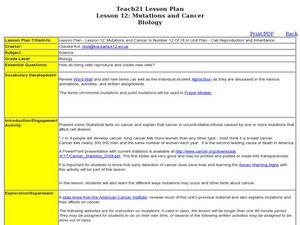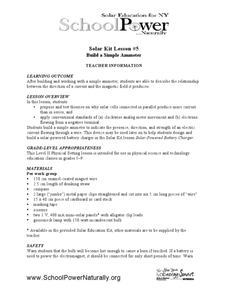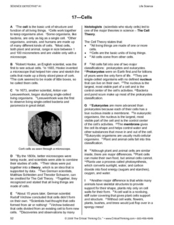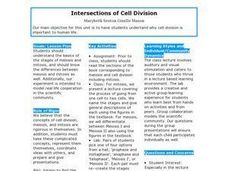Curated OER
Mutations and Cancer
High schoolers study how cancer cells mutate and affect cell division. For this investigative lesson students view a PowerPoint presentation learn the seven warning signs of cancer.
Curated OER
Genetic Disorders
Young scholars examine how living cells reproduce and how traits are passed on. In this genetic reproduction lesson students research a topic and present it to the class.
K20 LEARN
What's My Purpose In This Life? Intro To Cell Theory/Organelles
Why are we here? Well, if you happen to be a Golgi body, the answer is simple! Young biologists embark upon a journey through the tiny world of cellular organelles with an engaging lesson from the K20 Center. The activities open with an...
Curated OER
Technology and Teen Abuse
Students research dating abuse, particularly as it affects teens in general and specifically when technology like cells phones and the Internet is involved. They develop and use a survey on dating abuse in thier school and use the...
Curated OER
Solar Kit Lesson #5 - Build a Simple Ammeter
Emerging electricians build a simple ammeter for making measurements on an electric current. They test the placement of solar cells in both series and parallel circuits and examine the magnetic field produced by the movement of electrons...
Curated OER
Mutations
After studying DNA replication and the genetics of inheritance, this slide show is useful for explaining specific mutations that can happen and result in an illness. Sickle cell anemia, and cystic fibrosis are explained on a genetic...
Curated OER
Driving Safety and Distractions
Students research process necessary to add local or state law limiting such driving distractions as cell phones or other technological devices, interview city leaders or legislators, research areas that already have such legislation and...
Curated OER
Cells Group Creative Writing
Tap into writing skills in your science class with this creative writing activity! Get your class to learn the words mitochondria, cytoplasm, chloroplast, chlorophyll, nucleolus, nucleus, tissues, organs, vacuole, and chromosome by...
Curated OER
Mobile Phones
Why do we use phones? How does our language change on the phone? Learners practice phone conversations with the dialogues provided. They practice written phone dialogues with a partner, and create and perform phone conversations to...
Curated OER
Mitosis and the Cell Cycle
Uncomplicated and useful, this PowerPoint introduces viewers to the five stages of mitosis. For each stage, there is a slide that lists the main occurrences. Show this as a note-taking guide when you lecture on mitosis to keep your young...
Curated OER
Study Guide for Chapter 12: The Cell Cycle
In this biology worksheet students map out and describe the process of mitosis for the nine questions. The last four questions are several combined in each.
Curated OER
Cell Phones with Cameras Banned in Locker Rooms
Young scholars research the way phones work and what places - both locally and nationally - have already faced the problem of in appropriate use. Students also interview gym owners or managers in their community and those who use they...
Curated OER
Cell 3: Organelles B
Students, after researching cells, construct a model cell. They explain the structure and function of eukaryotic organelles in a presentation. In addition, they create their own analogies to describe the structure and function of...
Curated OER
Structure and Function of the Cell/Introduction to the Cell
So, this is not technically a learning exercise, but rather a chapter of reading material, pictures, and diagrams introducing young biologists to the cell. Cell theory, diversity, size, and shape are described. The internal organization...
Curated OER
17 - Cells
The first of three pages in this handout provides a brief history of our understanding of the cell. It also differentiates between prokaryotic and eukaryotic cells. The second is a collection of true and false, multiple choice, and short...
Curated OER
Stem Cell Development
Like a fresh canvas, stem cells can turn into almost anything. In a comprehensive lesson, high school biologists use clay to build a 3-D model of cell division and the processes that occur during the first 14 days of development. Also...
Curated OER
Extracting DNA from Your Cells
Three steps are needed to extract DNA from learners' inner cheek cells. The procedure and reasons for each step are explained. As enzymes work on the cells, a series of questions are answered regarding the structure of the DNA molecule....
Cornell University
The Galvanic Cell Game
Play a little game with your classes! Young scholars expand on their understanding of oxidation/reduction reactions in a game-based activity. They build a Galvanic cell with game pieces while learning about each component and their...
Curated OER
Intersections of Cell Division
Young scholars listen to a lecture covering the process of going from one cell to two cells. Using the textbook, students differentiate between meiosis I and Meiosis II. Young scholars work in pairs to create one stage using pipe...
Colorado State University
What Is a "Convection Cell"?
Round and round in circles it goes! A hands-on activity has learners recreate a model of a convection cell. They watch as the difference in density of their materials creates a current.
Illustrative Mathematics
Cell Phone Plans
Turn your classroom into a local cell phone store. Then, have your cell phone agents use linear equations to visually display three cell plans and their advantages. It makes for a great group project. Discuss how to decide which plan is...
Personal Genetics Education Project
Protecting Athletes with Genetic Conditions: Sickle Cell Trait
Should school and professional teams test athletes for sickle cell trait? Will it protect them by providing knowledge or lead to discrimination by not allowing them to participate in sports? After learning about this genetic disorder,...
Curated OER
Words in the News: Stem Cell Research
A thorough resource for intermediate English learners addresses reading comprehension of informational texts, adjective forms, vocabulary acquisition, and writing in a journalistic style. Specifically, the class reads about stem cell...
Curated OER
The Cell Phone Age
What kid isn't interested in Cell phones? They are technical and to operate them you must read an informational text. Older elementary students read an informational text, match vocabulary words with their meanings, and create sentences...
Other popular searches
- Cell Biology
- Cell Parts
- Cellular Respiration
- Cell Organelles
- Animal Cells
- Plant and Animal Cells
- Cell Structure
- Cell Cycle
- Cell Membrane
- Cell Reproduction
- Cell Theory
- Plant Cells























